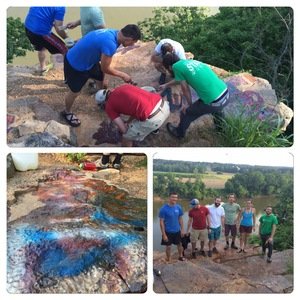Graffiti has always been a big problem in the South, and although most people would love to see it disappear, we’ve come to accept it as part of the landscape. The SCC attempted graffiti removal efforts over a decade ago, to no avail. Attempts at chemical removers, scrubbing and lots of elbow grease proved no match for the extensive graffiti littering our natural areas. The closest we ever came to ridding our landscape of these eyesores was using a natural paint to cover the graffiti and attempt to blend the paint colors into the rock. This method worked great, but was very time consuming and not logical for a large scale removal effort.
There are a few climbing areas in the Southeast that have essentially been abandoned by climbers because of the trash and graffiti. In 2015, the SCC decided it was time to start looking into graffiti removal options. There had to be something out there that would work! After extensive research, communication with other local climbing organizations and the Access Fund Conservation Team, we found a few products that seemed hopeful. We found a product, Elephant Snot, which seemed to be the best bet for our porous sandstone, so we decided to give it a try.
After ordering a test batch, we started testing the product at different areas. We set out with the elephant snot, a weed sprayer, gloves and brushes to conduct our first test graffiti removal. After a few tests, we found that some graffiti just melted away in seconds, with no need to brush, but others required a lot of time and scrubbing. We figured many factors could affect this: color of the paint, thickness of the paint, age of the graffiti, and porousness of the rock. We tested at various sites and had fantastic results at all of them! Most, if not all, of the graffiti was removed, leaving little or no evidence behind!
The process is simple and requires one key factor: PATIENCE. After some trial and error, here is the process we find works best for all areas:
Paint the Elephant Snot over the graffiti with a paint brush. Don’t be stingy with the Snot, make sure graffiti is fully covered in a thick coat.
Let it Sit. We found that letting it sit for at least 20 minutes before attempting to wash it off is adequate in most situations, but 30 minutes-1 hour proved best
Brush. While it’s resting, brush, brush, brush. Use soft bristle brushes (like the ones you would use to wash your car tires) to scrub and scrub and scrub. Use a little spray of water to ignite the bubbly effect of the Elephant Snot and let it do its job. I would recommend scrubbing at least 5-6 different times during the half hour-1 hour waiting period.
Rinse. A pressure washer is the best for rinsing. But, if you don’t have access to a pressure washer or can’t get it to the graffiti, use the highest pressure weed sprayers you can find. If using a weed sprayer, spray slowly and close to the rock. *If using a pressure washer make sure the pressure isn’t too high so it doesn’t break the rock. Be extra cautious around holds on routes.*
The graffiti removal efforts that were made possible by the support of the Cornerstone Conservation Grant. The grant has had a huge impact on our ability to bring natural areas back to their original state while improving relationships with land owners and educating the community. This project had a reach farther than we could have ever imagined. We look forward to continued efforts in preserving climbing areas for generations to come.
If you have any questions about graffiti removal, please reach out to Cody Roney of the Southeastern Climbers Coalition at: [email protected]

